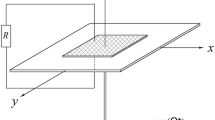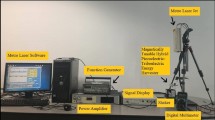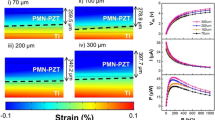Abstract
A flexoelectric energy harvesting can be a viable solution of energy source for low power devices and sensors due to its higher performance at nano/micro domain size. Numerical study has been performed on energy harvester based on flexoelectric phenomenon of dielectric materials. Cantilever type structure was opted here as it induces the polarization due to the breaking of lattice symmetry upon bending. Host layer of cantilever is made of barium strontium titanate (BST) as it has high flexoelectric coefficient, and electrodes are attached with the host layer to collect the charges. In this study, nonlinearity has been introduced using pair of magnets at the free end of the cantilever. Characteristics of the harvester performance (linear–non-linear) changes by varying the distance between magnets. Results revealed that the bistable energy harvester gives more operating frequency range when excitation is random as compared to the linear energy harvester. For the given dimension of the harvester, when magnets distance d = 6 mm, effective harvesting frequency ranges are 5–17.3 and 17.6–26 Hz as compared to linear harvester. Further, role of load resistance was investigated to understand the impact on the performance. Hysteresis loop between voltage and displacement significantly varies with the resistance. This hysteresis loop confirmed the backward coupling of flexoelectric layer, in which voltage affects the displacement due to actuation. Area under the hysteresis loop is maximum for optimum resistance value (20.4 kΩ) which confirms the maximum extraction of power during vibration.





Similar content being viewed by others
References
N.G. Stephen, J. Sound Vib. 293, 409 (2006)
A. Erturk, D.J. Inman, Smart Mater. Struct. 18, 025009 (2009)
Y.C. Shu, I.C. Lien, Smart Mater. Struct. 15, 1499 (2006)
H.A. Sodano, D.J. Inman, G. Park, J. Intell. Mater. Syst. Struct. 16, 799 (2005)
G.K. Ottman, H.F. Hofmann, A.C. Bhatt, G.A. Lesieutre, IEEE Trans. Power Electron. 17, 669 (2002)
K.A. Cook-Chennault, N. Thambi, A.M. Sastry, Smart Mater. Struct. 17, 043001 (2008)
S. Priya, D.J. Inman, Energy Harvesting Technologies (Springer, Boston, 2009)
S.P. Beeby, R.N. Torah, M.J. Tudor, P. Glynne-Jones, T. O’Donnell, C.R. Saha, S. Roy, J. Micromech Microeng 17, 1257 (2007)
P.D. Mitcheson, E.M. Yeatman, G.K. Rao, A.S. Holmes, T.C. Green, Proc. IEEE 96, 1457 (2008)
S. Roundy, J. Intell. Mater. Syst. Struct. 16, 809 (2005)
S. Kim, W.W. Clark, Q.M. Wang, J. Intell. Mater. Syst. Struct. 16, 847 (2005)
F. Goldschmidtboeing, P. Woias, J. Micromech. Microeng. 18, 104013 (2008)
M.J. Guan, W.H. Liao, Smart Mater. Struct. 16, 498 (2007)
F. Cottone, H. Vocca, L. Gammaitoni, Phys. Rev. Lett. 102, 080601 (2009)
A.F. Arrieta, P. Hagedorn, A. Erturk, D.J. Inman, Appl. Phys. Lett. 97, 104102 (2010)
Q. Deng, M. Kammoun, A. Erturk, P. Sharma, Int. J. Solids Struct. 51, 3218 (2014)
W. Zeng, X.-M. Tao, S. Chen, S. Shang, H.L.W. Chan, S.H. Choy, Energy Environ. Sci. 6, 2631 (2013)
K.F. Wang, B.L. Wang, Int. J. Eng. Sci. 116, 88 (2017)
H.S. Tzou, X.F. Zhang, J. Vib. Acoust. 138, 031006 (2016)
J.F. Scott, J. Phys. Condens. Matter 25, 331001 (2013)
W. Huang, F.G. Yuan, X. Jiang, in Structural Health Monitoring (SHM) in Aerospace Structures, ed. By F.-G. Yuan (Elsevier, 2016), p. 149
S. Chandratre, P. Sharma, Appl. Phys. Lett. 100, 023114 (2012)
M. Zelisko, Y. Hanlumyuang, S. Yang, Y. Liu, C. Lei, J. Li, P.M. Ajayan, P. Sharma, Nat. Commun. 5, 4284 (2014)
M.S. Majdoub, P. Sharma, T. Cagin, Phys. Rev. B Condens. Matter Mater. Phys. 77, 125424 (2008)
P.S.M.S. Majdoub, T. Cagin, M. Majdoub, P. Sharma, T. Cagin, Phys. Rev. B 77, 1 (2008)
K.F. Wang, B.L. Wang, Compos. Struct. 153, 253 (2016)
A.G. Moura, A. Erturk, J. Appl. Phys. 121, 064110 (2017)
A. Kumar, A. Chauhan, R. Vaish, R. Kumar, S.C. Jain, J. Electron. Mater. 47, 394 (2018)
R. Maranganti, N.D. Sharma, P. Sharma, Phys. Rev. B Condens. Matter Mater. Phys. 74, 014110 (2006)
A. Abdelkefi, Int. J. Eng. Sci. 100, 112 (2016)
X. Zhou, S. Gao, H. Liu, Y. Guan, Smart Mater. Struct. 26, 015008 (2017)
A. Pasharavesh, M.T. Ahmadian, Appl. Math. Model. 41, 121 (2017)
Q. Deng, L. Liu, P. Sharma, J. Mech. Phys. Solids 62, 209 (2014)
K. Chu, C.H. Yang, Phys. Rev. B 96, 104102 (2017)
A.G. Petrov, F. Sachs, Phys. Rev. E Stat. Phys. Plasmas Fluids Relat. Interdiscip. Top. 65, 021905 (2002)
E.N. Bunting, G.R. Shelton, A.S. Creamer, J. Am. Ceram. Soc. 30, 114 (1947)
J. Li, D. Jin, L. Zhou, J. Cheng, Mater. Lett. 76, 100 (2012)
P. Padmini, T.R. Taylor, M.J. Lefevre, A.S. Nagra, R.A. York, J.S. Speck, Appl. Phys. Lett. 75, 3186 (1999)
H. Khassaf, N. Khakpash, F. Sun, N.M. Sbrockey, G.S. Tompa, T.S. Kalkur, S.P. Alpay, Appl. Phys. Lett. 104, 202902 (2014)
A. Tombak, J.-P. Maria, F. Ayguavives, G.T. Stauf, A.I. Kingon, A. Mortazawi, IEEE Microw. Wirel. Compon. Lett. 12, 3 (2002)
A. Tombak, J.P. Maria, F.T. Ayguavives, Z. Jin, G.T. Stauf, A.I. Kingon, A. Mortazawi, IEEE Trans. Microw. Theory Tech. 51, 462 (2003)
L.M. Garten, S. Trolier-Mckinstry, J. Appl. Phys. 117, 094102 (2015)
W. Ma, L.E. Cross, Appl. Phys. Lett. 81, 3440 (2002)
S.R. Kwon, W.B. Huang, S.J. Zhang, F.G. Yuan, X.N. Jiang, Smart Mater. Struct. 22, 115017 (2013)
S. Patel, A. Chauhan, J. Cuozzo, S. Lisenkov, I. Ponomareva, R. Vaish, Appl. Phys. Lett. 108, 162901 (2016)
X. Jiang, W. Huang, S. Zhang, Nano Energy 2, 1079 (2013)
D. Lee, A. Yoon, S.Y. Jang, J.G. Yoon, J.S. Chung, M. Kim, J.F. Scott, T.W. Noh, Phys. Rev. Lett. 107, 057602 (2011)
Z. Wang, X.X. Zhang, X. Wang, W. Yue, J. Li, J. Miao, W. Zhu, Adv. Funct. Mater. 23, 124 (2013)
S. Baskaran, N. Ramachandran, X. He, S. Thiruvannamalai, H.J. Lee, H. Heo, Q. Chen, J.Y. Fu, Phys. Lett. Sect. A Gen. At. Solid State Phys. 375, 2082 (2011)
J. Narvaez, S. Saremi, J. Hong, M. Stengel, G. Catalan, Phys. Rev. Lett. 115, 037601 (2015)
W. Ma, L.E. Cross, Appl. Phys. Lett. 79, 4420 (2001)
X. Liang, R. Zhang, S. Hu, S. Shen, J. Intell. Mater. Syst. Struct. 28, 2064 (2017)
S.-B. Choi, G.-W. Kim, J. Phys. D Appl. Phys. 50, 075502 (2017)
W. Ma, L.E. Cross, Appl. Phys. Lett. 78, 2920 (2001)
W. Ma, L.E. Cross, Appl. Phys. Lett. 88, 232902 (2006)
W. Ma, L.E. Cross, Appl. Phys. Lett. 86, 1 (2005)
W. Huang, S.R. Kwon, S. Zhang, F.G. Yuan, X. Jiang, J. Intell. Mater. Syst. Struct. 25, 271 (2014)
A. Kumar, A. Sharma, R. Kumar, R. Vaish, V.S. Chauhan, J. Asian Ceram. Soc. 2, 138 (2014)
W. Al-Ashtari, M. Hunstig, T. Hemsel, W. Sextro, Smart Mater. Struct. 21, 035019 (2012)
Acknowledgements
Rahul Vaish thanks Indian National Science Academy, New Delhi for financial support.
Author information
Authors and Affiliations
Corresponding author
Appendix
Appendix
Displacement field and potential in terms of nodal values are given as
Based on displacement and voltage nodal value, strain and electrical field can be written as:
\({B_{\text{q}}}\) is gradient matrix, \({H_\phi }\) is hessian matrix of displacements field and voltage respectively.
Matrices used in Eqs. 2 and 3 can be written as:
Strain energy in element:
where
Electrical energy in element:
where
where C is material properties matrix, µ is flexoelectric coefficients matrix and β is dielectric constant matrix.
Kinetic energy in element:
where
N are the shape functions.
Rights and permissions
About this article
Cite this article
Kumar, A., Sharma, A., Vaish, R. et al. A numerical study on flexoelectric bistable energy harvester. Appl. Phys. A 124, 483 (2018). https://doi.org/10.1007/s00339-018-1889-6
Received:
Accepted:
Published:
DOI: https://doi.org/10.1007/s00339-018-1889-6




